Keeping Your RV Cool This Summer
One morning you pull into a beautiful but primitive forest service campground. Even though the place is almost full, there’s one site available with a few trees and a clear view of the lake. You can’t believe your luck! Quickly you pay for your pass and set up on your piece of paradise.
Everything’s hunky-dory until about 2:00pm.
Suddenly it’s bright. Really bright. And hot. You look up to see that the sun has cleared the pines, and your shade has headed east.
Your beautiful tin box quickly turns into an oven.
Now you know why this site was available. Sometimes finding a spot with afternoon shade is even more important than the view.
Keeping Your RV Cool on a Hot Summer’s Day Can Be Challenging
Why does your rig heat up so quickly? Insulation is the quick answer.
Some RVs, motor homes, and travel trailers have more insulation in the ceiling and walls than others. As a comparison, a typical house wall has an R-Value of 21 (and it’s 6″ thick or more). An RV wall is around 1.5″ thick with an R rating of only 5 to 7. On a sunny day, you can actually feel the sun baking right through. An RV roof can be between R-10 and R-20.
Sometimes, even two air conditioners can’t keep up. Let’s look at some solutions.
Here are Some Ways of Keeping Your RV Cool on a Sweltering Summer Day
- Block the sun’s UV rays.
- Reflect the sun’s UV rays.
- Create more cool air.
- Cool down with evaporation.
- Adding Insulation Easily.
Keeping Your RV Cool by Adding Shade
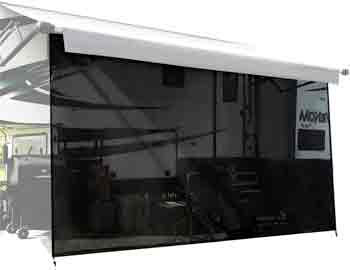 Ah, to be ensconced under a canopy of tall trees waving in the wind. But that rarely happens. Even in a shady campsite, the sun beats on the camper for at least part of the day.
Ah, to be ensconced under a canopy of tall trees waving in the wind. But that rarely happens. Even in a shady campsite, the sun beats on the camper for at least part of the day.
Awnings are a great way to create shade on your RV. When the sun is low in the sky, an awning might not get low enough to block the sun. An RV Sun Screen added to your awning might be just the thing. The RV Sun Shade Screen show is 10′ by 18.5′, but this company has over a dozen sizes advertised. The fabric will block 86% of the sunlight, which will reduce the temperature immediately.
This mesh screening has a one-way feature, letting you see out but hindering those on the outside from seeing in. You can get them for the sides of the awning too.
If you can find a way to tie it on, you could use it on the other side of the camper too.
Exterior Window Blinds:
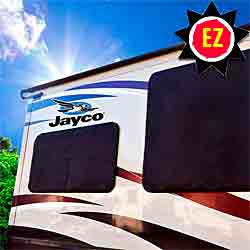
Exterior, see-through, window blinds by EZSnap block 90% of the suns harmful UV rays without blocking the view.
Blocking the UV rays before they enter your home is seven times more efficient than inside blinds.
“Non-Fray” Thermo-Weave™ window shading kits will fit any size or type of window. Just cut to size and snap into place.
Add Slide Out Toppers
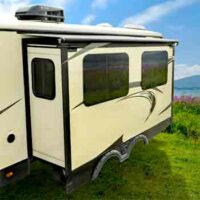
A slide-out awning extends over the top of your RVs slide-out. This provides your RV slide-out with an extra layer of protection, and this additional protection, shade in the summer. You can rest easy knowing that this small investment will help keep your RV safe from the outdoor elements and in optimal working condition.
The slide-out awning frame assembly also helps keep the interior of your RV cooler. It does so because of the UV-resistant nature of the awning fabric, which blocks a large amount of sunlight from shining directly onto your slide-out and transferring heat to the interior. This means that you and your passengers can have a much easier time staying comfortable and relaxed while camping out in your RV, even during the hot days of summer.
Shade your RV roof for remarkable cooling
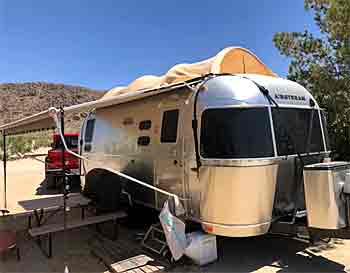
Awning sun shades are great, but they do nothing for the roof. Take a look at the photo at the top of the screen to see a unique product called Shade RV.
Shade RV provides 95% ultraviolet (UV) protection to the top of your RV, also covering caulking and plastic vent covers. This product uses a strong, HDPE fabric that won’t rot or absorb moisture. It is made from monofilament yarn and tape that features a unique lock-stitch pattern to provide a stable fabric and excellent levels of UV protection.
Customers report that it stays on even in strong winds and through storms. Your air conditioner can operate just fine (actually better) underneath it, and you can still open your roof vents and run exhaust fans.
You can expect to reduce your air-conditioning costs by up to 35%.
And even with the reflective metal surface of an Airstream trailer, as this picture shows, they can benefit just as much.
Mylar Space Blanket over a van or metal vehicle
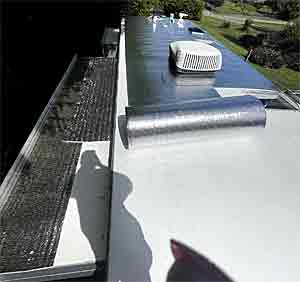
One reader suggested using a Mylar space blanket attached with magnets to reflect the suns rays. Slip a couple of pool noodles underneath to hold it away from the metal surface of the vehicle.
Using Reflexit Reduced the Heat and Sound
Another Facebook poster added rolls of Reflexit reflective bubble wrap to her roof with Velcro double-sided tape and reduced the heat but also notice a reduction in noise that she appreciated.
Reflect the sun’s harmful UV rays
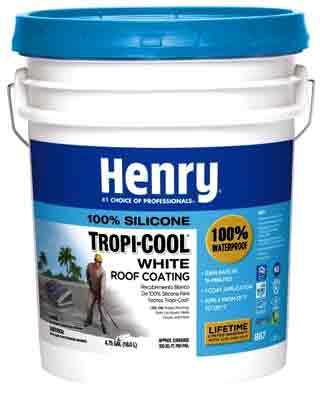
Coating your roof with a highly-reflective coating will help keep your RV, travel trailer, or motor home cooler.
Henry 887 Tropi-Cool 100% Silicone White Roof Coating is a premium, 100% silicone, moisture-cure coating designed to reflect the sun’s heat and UV rays, as well as protect many types of roofs. While suitable for use in all climates, the 100% silicone chemistry is especially suited for extreme tropical environments, which are exposed to some of the hottest and wettest weather with intense UV exposure. It is specially designed to maintain maximum reflectivity of heat and UV rays as it ages. Its moisture-cure chemistry creates a very aggressive chemical bond with the roof, which allows for permanent ponding water resistance, extreme durability, and superior capabilities of sealing and protection.
You need to clean the roof well before applying. No primer needed on new roofs or roofs in excellent condition. It can be applied with temperatures between 35° to 120°F.
While we normally warn against using silicone-based products like Flex-Seal, on an EPDM RV roof this product does not use solvents to cure, so it won’t dissolve the rubber coating of the RV roof. Our readers report a considerable temperature drop just by applying Henry Tropi-Cool.
I just coated my motor home’s roof with Henry Tropi-Cool. See how it turned out here: Henry Tropi-Cool RV Roof Coating.
If your roof is in poor condition, see this page of the website on repairing or replacing the coating on your roof: How to refinish or repair your RV Roof.
If your Airstream trailer has a dull, oxidized finish see this page for directions on shining up like new: Restoring and remodeling an Airstream Trailer
Increase the Efficiency of your RV Roof Air Conditioner(s)
Some RVs have duct work in the ceiling that directs the air-conditioned air into all areas of the RV. However, there has been little thought in how the air from the conditioner flows into the duct. One guy, a retired HVAC specialist, realized that a simple foam insert could direct the air into the ducts without turbulence and back pressure, significantly increasing the efficiency of his air conditioners. There’s a kit for almost every AC/RV combination. The kit costs $170.00*
The foam blocking also ensures that all of the cold air gets into the ducts instead of being sucked right back into the air conditioner’s exhaust. This prevents the air conditioner from freezing up. It also causes it to operate more quietly.
See how easy the RV Airflow System is to install by watching this YouTube® video.
Many new RVs now come with this airflow system already installed. If yours didn’t, it’s actually easy to install. Here’s list of compatible RVs.
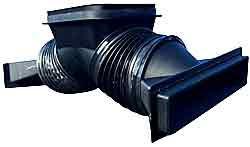
Another manufacturer of these RV air conditioner modification products is KoolRV Affordable Innovations. Their kit uses molded plastic vent adapters and ducting to accomplish the same result as RV Airflow. The kit is easy to install but only fits about 10 air conditioner models. While not quite as good at lowering the sound volume they only cost $74.95* for each one.
Cleaning and Repairing Your Air Conditioner
Here is a great informational video from The Great Outdoors RV showing the different types of RV air conditioners, and how to fix or avoid the most common issues with their operation.
Cleaning your external air conditioner radiator
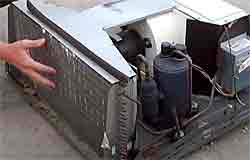
Vacuum or spray dirt and debris from the radiator section of your rooftop air conditioner. This is especially important if you live in an area with a lot of cottonwood trees. Use Nu-Calgon Evap Foam spray cleaner to make the job easy.
Be careful not to bend any of the aluminum fins in the radiator.
There is a smaller radiator accessible from the inside of the RV that also should be kept free of dust and particulates.
Straighten the Radiator Fins
The air conditioner radiator has delicate fins that can be easily bent. Use this tool set to straighten the fins to maintain maximum cooling.
Regularly straightening and cleaning your air conditioner with fin straightener tool will increase the efficiency of your air conditioner. Fin cleaning kits are suitable for condensers, evaporators, air conditioners, etc. Different sizes of air conditioner Fin Comb and Fin Cleaning Brush as a combination can help you solve the problem at once and bring a lot of convenience to your life.
Make sure all of your cold air is getting out of the vents
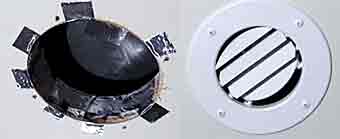
In the same way the RV Airflow System gets your cold air into the duct work, make sure the cold air is getting out of the vents efficiently on the other end.
Doug from Doug’s RV Improvements shared this tip in his YouTube® video, Tips To Improve The Ducted AC In Your RV. He opened one of the ceiling vents and notices a gap between the duct and the ceiling, letting a lot of cold air go wastefully into the attic space. Using metallic duct tape, he sealed this gap then replaced the vent cover. A lot more air came out the vent so he did this with every vent, improving the cooling.
Keeping Your RV Cool by Adding Another Air Conditioner
Adding an additional air conditioner to help in keeping your RV cool will present some technical hurdles, but it might be an idea to consider.
Long trailers and RVs can have multiple air conditioners on the roof. If you only have one and want to add a second, see if your RV’s power supply can handle the load. If you have a 50-amp system, you’ll be able to run a second AC. I would advise adding “soft-starts” to each unit. You’ll need to be careful about running both ACs along with other electric guzzlers like the microwave oven.
If your travel trailer is made to accept a second AC but only came with one, there may be a vent or skylight already installed in the hole which was intended for an air conditioner. Because they are heavy, the AC roof unit must be centered in the roof. Do not replace a shower vent or range hood vent with the AC unit. If the wiring is not already there, you will need to run it from your power center. You can make it a little less obtrusive by running the wire through an on-wall conduit.
Adding a mini-split instead of a roof-mount air conditioner
A mini-split, like the one shown, might be a better option for you. The heavy condenser unit can be placed lower down, like on the tongue or rear fender. Sadly, the hoses that run to the inside unit will be visible externally on your rig. You’ll need to decide of you can accept the unsightly hoses.
A mini-split is usually lighter weight than a rooftop AC, and more efficient. They are also quieter than the rooftop air conditioners.
There are several ways it can be wired for power. The easiest is to run a heavy-duty power cord directly to the 20 amp outlet of the electrical pedestal of the RV park. It could also be wired through your RV’s power center if there is room for an additional circuit breaker. I recommend having a professional do this.
The Hessaire 12,000 BTU 1-Ton Mini Split provides improved efficiency ratings up to 17.9 SEER (that’s a very good rating) and delivers high performance from the moment it’s activated. In addition, its competitive price (Just $799.00* from The Home Depot) makes it a consumer favorite that’s tough to beat.
Extremely Efficient Variable Speed Inverter Technology
The Hessaire single-zone condenser and wall-mounted air handler is an ideal combination of superior product quality, energy efficiency, quiet (Just 24db) operation, and financial value. The pre-charged outdoor condenser makes DYI installation a breeze, and allows for the line set to be trimmed to size without losing precious coolant. The condenser incorporates a high-performance compressor with eco-friendly, chlorine-free R-410A refrigerant.
Having a variable speed inverter means this model does not have the huge start-up current draw of other types of mini-splits. The compressor starts at minimum speed, avoiding high inrush current. It runs at the most efficient speed for the cooling need. No need to add a soft-start like regular RV air conditioners need. This makes it very easy on power consumption.
Replacing Your Existing Roof-Mount Air Conditioner
If your roof-mount air conditioner has failed, RECPRO is a source for replacements. They’re expensive, but you can get 15k BTU/H at a quiet 55 db. There are ducted and non-ducted with built-in heat pumps. 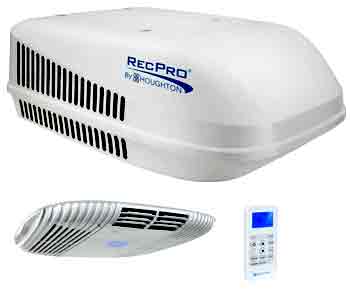
The temperature monitoring system
Do you like to leave the AC on while you sleep? Because our bodies are naturally cooler when we sleep, leaving the air conditioner running can result in an uncomfortably frosty morning . To prevent this, the air conditioning unit shown here has a temperature monitoring system that senses the temperature of the surrounding air and adjusts to accommodate whatever temperature you’ve set it to, keeping you comfortable even through the night.
Energy Efficient
The RECPRO Air Conditioners use an efficient 14 amps running and only 16 amps on startup. The low amp draw on this model enables it to not only keep your energy use lower than other models, but it allows you to use more than just the AC unit at one time. For other models that have a higher amp draw, you have to think about how many appliances are on that circuit, as the circuit breaker can only handle so much. With the low amp draw of this model, however, you have more room for other appliances. Saving you power and frustration, it’s definitely the best brand for energy efficiency.
Most RV air conditioning units blow the air from the top unit through the space between them and out of the bottom unit without a tube to control the air. With the air moving around in the space between, it loses some of the temperature quality and cleanliness. With the directional tube in this model, the airflow is controlled to provide optimal temperature quality and cleanliness.

RECPRO specializes in high quality RV replacement parts. You’ll find anything and everything you’d ever need to keep your RV in top-notch condition. Guaranteed to be the highest quality with excellent customer service.
For a list of our recommendations of the best air conditioners visit this page: Best Air Conditioners for RVs and Tiny Houses
Create more cool air with Zero Breeze Battery Powered Air Conditioner:
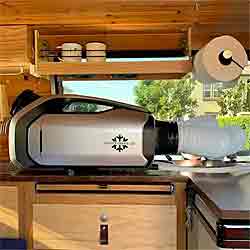
If you don’t have an air conditioner but still want to keep cool, consider the Zero Breeze Portable Air-conditioner.
The Zero Breeze Mark III, is an actual mini air conditioner. It runs off the 24 volt battery pack shown on the bottom of the unit for 2-7 hours. The ZeroBreeze Mark III will be available in the Spring of 2024. You can pre-order for $1,099.00 ($1,599.00 with battery).

Because it’s portable, it can be used in tents and screen rooms, or that room in your RV the roof top air conditioner doesn’t reach. See my YouTube® video I did using it in my RV.
There is a nifty install kit for RVs and tiny homes that adds ducting for intake and exhaust air. It draws air from the outside to cool the condenser of the A/C system, then exhausts the same air back outside. The inside air is recirculated through the front evaporator side.
This unit can be charged many ways: while driving, at home, even with portable solar panels. It produces 5280 BTU of cooling power and there is a heating function too.
Keeping Your RV Cool with the EcoFlow Wave
Like the Zero Breeze, the EcoFlow Wave is a real battery-powered air conditioner. It’s capable of producing 6100 BTU of cooling, and 6800 BTU for heating. The price starts at $1,449.00* and includes a snap on battery. It’s frequently on sale.
For longer run times you’ll need to pair it with an EcoFlow battery system.
The EcoFlow Wave portable air conditioner weighs just 39 lbs. and can be fully charged in just 2 hours when plugged into a wall outlet. It can also be charged via the 12 volt outlet in your vehicle while driving, as well as through their briefcase solar panels- even while it’s running!
They claim it can run for 8 hours per charge, but a lot of that time is just running the fan. It has built-in logic circuits to help it get the most out of the battery you use. The EcoFlow Wave can be fully controlled by the EcoFlow app on your smart phone.
EcoFlow 220W Bifacial Solar Panel will charge the EcoFlow Wave add-on battery in just 5 hours.
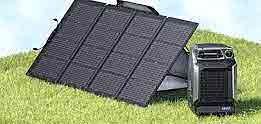
EcoFlow’s 220W Bifacial Portable Solar Panel is two in one. With a 220W primary side, and a 155W side on the back for ambient light, you can capture up to 25% more solar energy and charge your portable power station even faster.
It comes with its own carry case so you can take it anywhere. Once you arrive at your destination, simply unfold it and use it as a kickstand to get your sun exposure just right.
Fast Car Charger
EcoFlow has an 800 watt alternator charger (599.00) that will charge the WaveII in just 1.3 hours. The charger needs to be installed and requires a “smart generator adapter” for an additional $69.00. It’s a bit pricey but 8 times faster charging than thru the basic 12 volt plug in you car.
For information on EcoFlow’s portable power station jump to this page: Portable Power Centers How To Choose
Keeping Your RV Cool With Evaporation
RV owners struggle with excess moisture and mold, so we don’t want to ever add more moisture to the inside of an RV. But if you are sitting outside under your awning, you might consider an evaporation cooler.
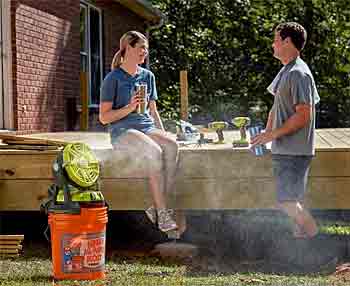
Misting fans have been used for many years so the technology is not new. Amusement parks and restaurants have been using misters to keep patrons cool for years.
Now Ryobi has produced a portable misting fan that works with their common power tool battery and a 5-gallon bucket of water.
RYOBI Misting Kits and Accessories are the easiest and most efficient way to provide the cool, comfortable surroundings you want. RYOBI introduces the 18-Volt ONE+ Bucket Top Misting Fan Kit. The RYOBI 18-Volt ONE+ Bucket Top Misting Fan Kit provides a portable cooling solution for the job site or any recreational activity.
This product can be run as just a fan, or you can turn on the water function to allow the 2 brass nozzles to release mist for more powerful cooling. The Hi/Lo switch for both the fan and mist, as well as the pivoting head, allow you to direct the perfect cooling experience. The base of this tool features a dual-purpose foot design, meant to sit on a 5-gallon bucket or lay on a flat surface and connect to a standard garden hose.
The Ryobi Misting Kit costs about $153.88*. Click image to see details.
Keeping Your RV Cool With These Simple Tips
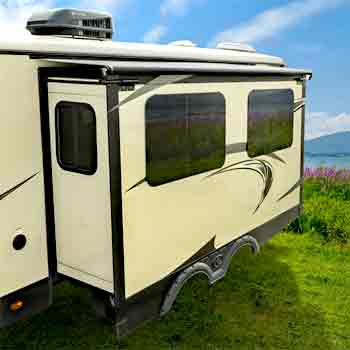
Click image to see details on Slide Toppers from RecPro. For a 5% discount at checkout use coupon code TINYLIFE
If you can, orient your RV in such a way so the sun will not hit you broadside in the afternoon. Otherwise, orient your RV so you catch the cross-breezes through the windows.
Pull the shades or blinds, and slide a piece of Reflective Foam Insulation Radiant Barrier between blinds and window to reflect the sun. Keeping cool uses almost the same methods as keeping warm. See more about increasing your insulation on this page: RV Winter Living How to prepare
Get the air moving with fans. See some clever fans on this page: Properly Venting a Tiny House
Open a window or vent just a bit on the far side of the RV from the air-conditioner so the air moves through the RV, exhausting hot stale air out of the vent.
Do your cooking outside. Here’s more information on that: Outdoor Cooking
Replace incandescent bulbs with cooler operating LED bulbs.
Add Insulation
Add awnings (sometimes called Slide Toppers) to your slide-outs. Slide a 2″ thick piece of foam board in between the topper and side out roof to add insulation.
Insulated Slide Out Wraps
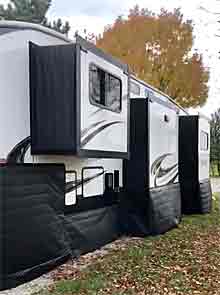
I don’t know why no one had thought of this before. Insulated side out wraps will definitely keep your rig warmer in the winter but also cooler in the summer. Invest in the comfort, protection, and aesthetics of your RV with the Skirting Company’s Insulated Slideout Wraps.
Slideout wraps are a must-have for any full-time RV family. These wraps not only protect your RV but also provide an additional layer of insulation, helping to regulate the temperature inside your RV. This can lead to energy savings and increased comfort during both hot summers and cold winters.
Slideout Wraps are 6 layers, 4 layers of that being foam. This insulated version provides an insulation value of R-7 and is UV-protected, flame-retardant, and mold-resistant. The temperature rating is -2 to -11.
Installing our RV Skirting Slideout Wraps is a breeze. Each wrap comes with all the necessary hardware, making it a DIY-friendly project for RV owners of all levels of experience.
Arthome Foam Panels
Arthome Foam peel-N-stick wall paper is thick foam. It look like brick but you can use it behind drawers, in cabinets and closets, even on the ceiling (if you don’t mind the look).

These Peel-and-Stick foam panels add insulation. They can flex to follow the contours of your rig. No need additional glue is needed. You can trim this brick wall panel simply with a household scissor for any size or shapes according to your area.
Many ways to keep warm in the winter also help you keep your RV cool in the summer
Adding insulation to exterior walls of cupboards will help.
See this page for more insulating ideas: RV Winter Living How to prepare
Other pages of this website you’ll be interested in:
Running RV Appliances Like Air-Conditioners Off-Grid
Best Air Conditioners for RVs and Tiny Houses
Melted RV Shore Power Plug How to Avoid Tragedy
How Best To Provide For Your Dog At The Campground
Comparing Pet Home Monitoring Systems



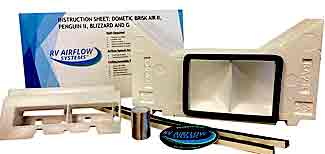



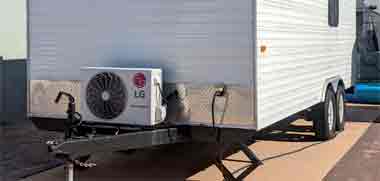
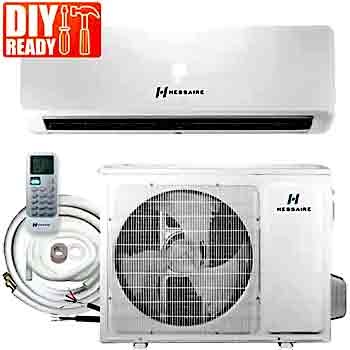
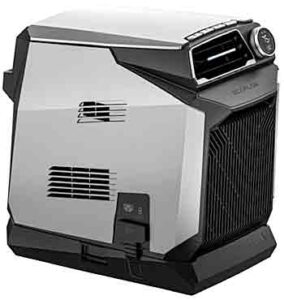
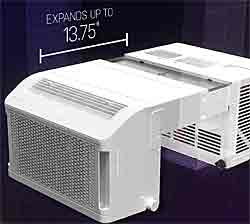


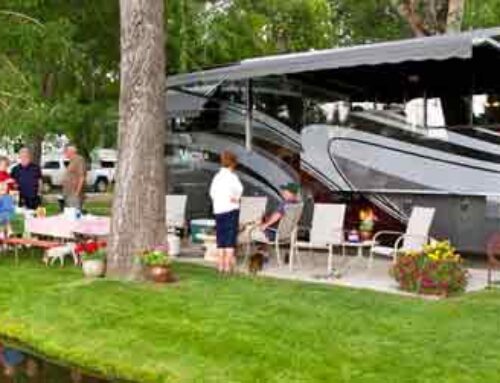
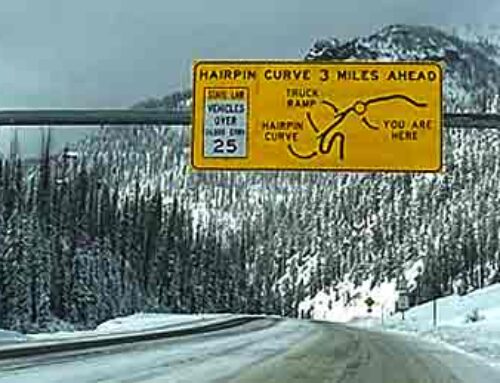
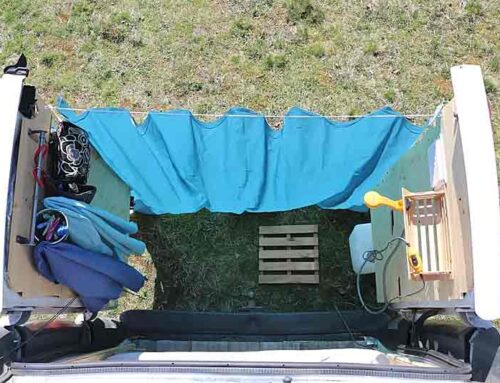
Great Information. Thanks for sharing
Welcome.